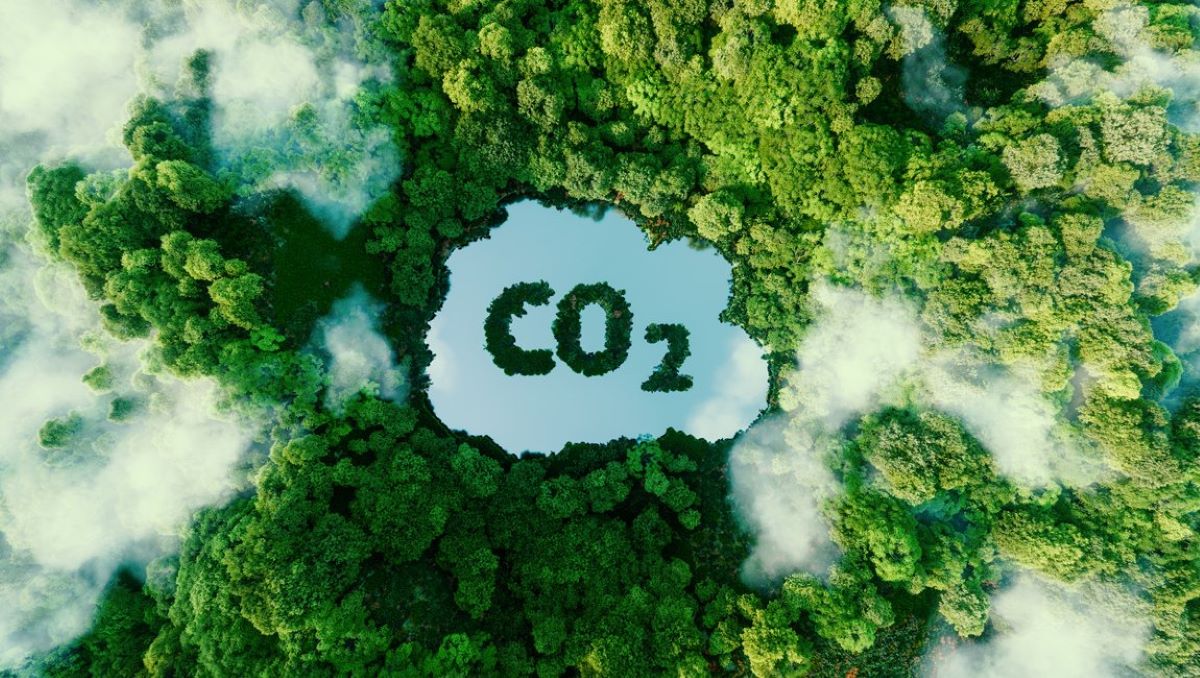Home>Gardening News and Trends>Explain How The Greenhouse Effect Works


Gardening News and Trends
Explain How The Greenhouse Effect Works
Modified: January 22, 2024
Discover the latest news on the greenhouse effect and learn how it works. Stay informed and understand the impact of this environmental phenomenon.
(Many of the links in this article redirect to a specific reviewed product. Your purchase of these products through affiliate links helps to generate commission for Chicagolandgardening.com, at no extra cost. Learn more)
Table of Contents
- Introduction
- What is the Greenhouse Effect?
- The Role of Greenhouse Gases
- How Does the Greenhouse Effect Work?
- Natural Greenhouse Effect vs. Enhanced Greenhouse Effect
- Consequences of the Greenhouse Effect
- Global Warming and Climate Change
- Solutions and Mitigation Strategies
- The Importance of Greenhouse Gas Reduction
- Conclusion
Introduction
The phenomenon of the greenhouse effect has garnered significant attention in recent years due to its role in climate change and its potential impact on our planet. As concerns about global warming continue to escalate, it is crucial to understand how the greenhouse effect works and its implications for our environment.
The greenhouse effect is a natural process that plays a vital role in maintaining Earth’s temperature and supporting life on the planet. Without it, our world would be inhospitably cold, making it impossible for life as we know it to survive. However, human activities have intensified the greenhouse effect, leading to concerns about rising global temperatures and its consequences.
In this article, we will explore the greenhouse effect in detail, including its definition, the role of greenhouse gases, how it works, and the difference between the natural and enhanced greenhouse effect. We will also delve into the consequences of the greenhouse effect, such as global warming and climate change, and discuss potential solutions and mitigation strategies.
By understanding the greenhouse effect and its implications, we can make more informed decisions about our actions to mitigate its negative effects and create a sustainable future for generations to come.
What is the Greenhouse Effect?
The greenhouse effect is a natural process that occurs in Earth’s atmosphere. It is named after the way a greenhouse traps heat from the sun to keep its interior warm. In the same way, certain gases in the Earth’s atmosphere act as a kind of “blanket,” trapping heat and preventing it from escaping back into space.
The primary gases responsible for the greenhouse effect are known as greenhouse gases. These include carbon dioxide (CO2), methane (CH4), nitrous oxide (N2O), and water vapor. While water vapor is the most abundant greenhouse gas, carbon dioxide has received considerable attention due to human activities such as burning fossil fuels, deforestation, and industrial processes, which have greatly increased its concentration in the atmosphere.
When sunlight reaches Earth, some of it is reflected back into space, while the rest is absorbed by the planet’s surface. The absorbed energy heats up the Earth, causing it to emit infrared radiation. Greenhouse gases in the atmosphere absorb part of this radiation and re-emit it in all directions, including back towards Earth’s surface.
This process of absorbing and re-emitting infrared radiation keeps the Earth’s surface warmer than it would be without the presence of greenhouse gases. Without the greenhouse effect, the average temperature on Earth would be a frigid -18 degrees Celsius (0 degrees Fahrenheit), making it impossible for life to thrive.
In addition to naturally occurring greenhouse gases, human activities have significantly increased their concentrations in the atmosphere. The burning of fossil fuels for transportation, electricity generation, and industrial processes has released vast amounts of carbon dioxide into the air. This increase in greenhouse gases has amplified the greenhouse effect, leading to a rise in global temperatures, a phenomenon known as global warming.
Understanding the greenhouse effect is crucial to comprehend the impact of human activities on the climate. By recognizing the role of greenhouse gases in trapping heat and raising temperatures, we can implement measures to reduce our carbon footprint and mitigate the effects of the enhanced greenhouse effect on our planet.
The Role of Greenhouse Gases
Greenhouse gases play a critical role in regulating Earth’s temperature and maintaining a habitable environment. Without these gases, the planet would be significantly colder, making it challenging for life to exist as we know it. While there are several greenhouse gases, carbon dioxide (CO2), methane (CH4), nitrous oxide (N2O), and water vapor are the most prominent contributors to the greenhouse effect.
Carbon dioxide is the main greenhouse gas responsible for the enhanced greenhouse effect. It is released into the atmosphere through natural processes such as respiration and volcanic activity, but human activities, particularly the burning of fossil fuels, have significantly increased its concentration. Fossil fuel combustion for transportation, industry, and energy generation has caused a sharp rise in carbon dioxide levels, contributing to global warming.
Methane is another potent greenhouse gas with a higher heat-trapping capability than carbon dioxide, although its concentration in the atmosphere is lower. Methane is produced through natural processes like wetland emissions and the breakdown of organic matter in landfills. However, human activities such as livestock farming, rice cultivation, and the extraction and transport of fossil fuels also contribute to its release. Reducing methane emissions is crucial for mitigating the greenhouse effect and curbing global warming.
Nitrous oxide is a less prevalent greenhouse gas but has a significant impact on the atmosphere’s heat-trapping capacity. It is emitted primarily through agricultural and industrial activities, including the use of fertilizers, the combustion of fossil fuels, and the burning of biomass. Nitrous oxide is also released naturally by microbes in soils and oceans. Limiting its production and release is vital to mitigate the greenhouse effect.
Water vapor is the most abundant greenhouse gas and plays a vital role in the natural greenhouse effect. As water evaporates from the Earth’s surface, it forms clouds and absorbs heat from the Earth. However, its concentration in the atmosphere is dependent on temperature, and it doesn’t significantly contribute to human-induced climate change. Instead, water vapor acts as a feedback mechanism, amplifying the warming effects caused by other greenhouse gases.
Understanding the role of greenhouse gases is essential for comprehending the causes and consequences of climate change. By reducing our emissions of carbon dioxide, methane, and nitrous oxide, we can mitigate the enhanced greenhouse effect and work towards a more sustainable future. Implementing sustainable practices, transitioning to renewable energy sources, and adopting efficient waste management strategies are all crucial steps in reducing greenhouse gas emissions and combating the challenges posed by the greenhouse effect.
How Does the Greenhouse Effect Work?
The greenhouse effect is a complex process that occurs naturally in Earth’s atmosphere. It involves the interaction between solar radiation, greenhouse gases, and the Earth’s surface. Understanding how the greenhouse effect works is crucial for comprehending the mechanisms behind climate change.
The greenhouse effect begins with the sun’s radiation reaching the Earth’s atmosphere. This solar energy consists of visible light, ultraviolet (UV) rays, and infrared (IR) radiation. About one-third of this incoming solar energy is reflected back into space by clouds, the atmosphere, and the Earth’s surface.
The remaining two-thirds of the solar energy is absorbed by the Earth’s surface, heating it up. As the Earth’s surface warms, it emits infrared radiation, which is a form of heat energy. This infrared radiation is then absorbed and re-emitted by greenhouse gases in the atmosphere.
Greenhouse gases, such as carbon dioxide (CO2), methane (CH4), nitrous oxide (N2O), and water vapor, have the unique property of absorbing this infrared radiation and trapping it within the Earth’s atmosphere. This trapped heat warms the lower atmosphere, known as the troposphere, and contributes to the overall temperature of the planet.
The greenhouse effect acts as a natural “blanket” for the Earth, preventing a significant amount of heat from escaping back into space. Without greenhouse gases, the Earth’s average temperature would be much colder, estimated to be around -18 degrees Celsius (0 degrees Fahrenheit).
However, human activities have significantly altered the balance of greenhouse gases in the atmosphere. The burning of fossil fuels, deforestation, and industrial processes have increased the concentration of carbon dioxide, methane, and other greenhouse gases. This enhanced greenhouse effect leads to an imbalance in the Earth’s natural radiation balance, resulting in increased global temperatures.
It’s important to note that the greenhouse effect itself is not inherently harmful. Without it, our planet would be too cold to support life. However, the intensification of the greenhouse effect due to human activities has led to global warming and climate change, causing numerous environmental, social, and economic challenges.
Understanding the workings of the greenhouse effect allows us to recognize the importance of reducing greenhouse gas emissions, implementing sustainable practices, and making informed decisions to mitigate the effects of climate change. By striving for a more balanced and sustainable approach, we can work towards preserving our planet for future generations.
Natural Greenhouse Effect vs. Enhanced Greenhouse Effect
The greenhouse effect is a natural and essential process that regulates Earth’s temperature and makes life on our planet possible. However, human activities have amplified this effect, leading to what is known as the enhanced greenhouse effect or anthropogenic global warming. Understanding the difference between the natural and enhanced greenhouse effect is crucial for comprehending the impact of human activities on our climate.
The natural greenhouse effect is a naturally occurring process that has been in place for millions of years. It involves the interaction between solar radiation, the Earth’s atmosphere, and greenhouse gases. When solar energy reaches the Earth’s surface, it warms the planet, and the surface radiates heat back into the atmosphere. Greenhouse gases, such as carbon dioxide, methane, nitrous oxide, and water vapor, trap part of this heat and re-radiate it in all directions, including back towards Earth’s surface. This natural process is vital for maintaining Earth’s average temperature at around 15 degrees Celsius (59 degrees Fahrenheit), enabling the existence of water in liquid form and supporting diverse ecosystems.
On the other hand, the enhanced greenhouse effect is the result of human activities that have significantly increased the concentration of greenhouse gases in the Earth’s atmosphere. The burning of fossil fuels, deforestation, industrial processes, and agriculture have released massive amounts of carbon dioxide, methane, and nitrous oxide into the atmosphere. These additional greenhouse gases trap more heat, leading to a buildup of thermal energy in the lower atmosphere. As a result, the average global temperature has been steadily rising, causing changes in climate patterns, more extreme weather events, and other detrimental impacts on the environment and ecosystems.
The enhanced greenhouse effect has far-reaching consequences for our planet. Rising global temperatures lead to the melting of glaciers and polar ice, causing sea levels to rise and threatening coastal communities. Changes in temperature and precipitation patterns affect agriculture and food production, potentially leading to food scarcity. Increased frequency and intensity of heatwaves, droughts, hurricanes, and floods pose risks to human health and disrupt ecosystems.
To mitigate the enhanced greenhouse effect and its negative consequences, it is crucial to reduce greenhouse gas emissions and transition to sustainable and clean energy sources. This requires efforts at both individual and global levels through energy conservation, increased use of renewable energy, reforestation, and the adoption of climate-friendly practices in agriculture, transportation, and industries.
Understanding the distinction between the natural greenhouse effect and the enhanced greenhouse effect empowers us to comprehend the impact of human activities on the climate and take meaningful actions towards mitigating climate change. By prioritizing sustainable practices and reducing greenhouse gas emissions, we can work towards restoring the balance of the greenhouse effect and preserving the health and integrity of our planet.
Consequences of the Greenhouse Effect
The greenhouse effect and the subsequent rise in global temperatures have numerous consequences for our planet and its inhabitants. The impacts of climate change, driven by the enhanced greenhouse effect, extend to various aspects of our environment, society, and the economy. Understanding these consequences is vital for developing strategies to mitigate and adapt to the challenges posed by climate change.
One of the most significant consequences of the greenhouse effect is global warming. As greenhouse gases trap heat in the Earth’s atmosphere, temperatures rise, leading to melting glaciers and ice caps. This results in rising sea levels, endangering coastal communities and delicate ecosystems. It also contributes to ocean acidification, threatening coral reefs and marine life.
Changing weather patterns are another consequence of the greenhouse effect. Increased temperatures lead to more frequent and intense heatwaves and droughts, impacting agriculture, water resources, and human health. On the other hand, warmer temperatures can also increase the likelihood of heavy rainfall and flooding, causing property damage, displacement, and loss of life.
Climate change affects ecosystems and biodiversity. These changes disrupt habitats and migration patterns, endangering plant and animal species. It also contributes to the spread of invasive species, alters food chains, and disrupts ecosystem services on which humans depend, such as pollination, air purification, and water filtration.
The greenhouse effect has social and economic consequences as well. It can exacerbate existing inequalities, as vulnerable populations, including low-income communities and developing countries, are often disproportionately affected by climate change impacts. Furthermore, climate change can lead to conflicts over resources, displacement of people due to rising sea levels or extreme weather events, and economic disruptions in sectors such as agriculture, tourism, and energy production.
Public health is also impacted by the greenhouse effect. Rising temperatures and changing weather patterns can increase the spread of diseases, such as malaria, dengue fever, and Lyme disease, as well as respiratory illnesses due to poor air quality. Heat-related illnesses and deaths are also more prevalent during heatwaves.
Mitigating the consequences of the greenhouse effect requires a combination of adaptation and mitigation strategies. Adaptation involves implementing measures to cope with the changes brought about by climate change, such as building seawalls, implementing water management strategies, and enhancing infrastructure resilience. Mitigation focuses on reducing greenhouse gas emissions through sustainable practices, transitioning to renewable energy sources, and promoting energy efficiency.
By acknowledging the consequences of the greenhouse effect, we can take proactive steps to mitigate its impact and work towards a more sustainable future. Through collective action, policy changes, and individual choices, we can strive to reduce greenhouse gas emissions and create a resilient and thriving planet for future generations.
Global Warming and Climate Change
Global warming is a direct result of the enhanced greenhouse effect, primarily caused by human activities. It refers to the long-term increase in Earth’s average surface temperature due to the accumulation of greenhouse gases in the atmosphere. Global warming is a key component of climate change – a broader phenomenon that encompasses shifts in weather patterns, temperature extremes, precipitation, and other climatic factors.
The consequences of global warming and climate change are widespread and profound. One of the most visible impacts is the shrinking of ice caps and glaciers, leading to rising sea levels. As temperatures rise, ice melts, adding water volume to the oceans and threatening coastal communities with increased risks of flooding, erosion, and saltwater intrusion into freshwater sources.
Climate change also affects weather patterns. It leads to more frequent and intense extreme weather events, such as heatwaves, droughts, hurricanes, and heavy rainfall. These events result in significant economic and social costs, including property damage, food and water shortages, displacement, and loss of life. Changes in precipitation patterns can also impact agriculture, disrupting food production and livelihoods.
The warming of the oceans contributes to the bleaching of coral reefs, damaging these vibrant ecosystems and threatening the diverse marine life they support. Shifts in temperature and ocean currents affect fish migrations and alter marine ecosystems, impacting fishing industries and coastal economies.
Global warming and climate change have far-reaching implications for biodiversity. As temperatures increase, ecosystems face challenges in adapting, leading to species extinctions and shifts in the distribution of plants and animals. Loss of habitat, disruption of food webs, and changes in reproductive patterns threaten the delicate balance of ecosystems worldwide.
Climate change also intersects with social and economic systems. Disadvantaged communities, including indigenous populations, are often disproportionately affected, facing greater exposure to climate-related hazards, limited access to resources, and social and economic vulnerabilities. Economic sectors such as agriculture, tourism, and energy production will also experience significant impacts from climate change, requiring adaptation strategies and transitions to more sustainable practices.
Mitigating global warming and addressing climate change require international cooperation and individual actions. Reducing greenhouse gas emissions through renewable energy adoption, energy efficiency improvements, and sustainable land management practices are essential steps. Adaptation measures, such as building resilient infrastructure, enhancing disaster preparedness, and developing climate-resilient agriculture, are also critical in minimizing the impacts of climate change.
Understanding the interconnectedness of global warming and climate change allows us to recognize the urgency of taking action to mitigate and adapt to the challenges they present. By adopting sustainable practices, supporting policy changes, and promoting environmental stewardship, we can work towards a more sustainable, resilient future for both people and the planet.
Solutions and Mitigation Strategies
Addressing the challenges posed by the greenhouse effect and climate change requires a multifaceted approach that combines mitigation and adaptation strategies. Mitigation strategies aim to reduce greenhouse gas emissions and limit the extent of global warming, while adaptation strategies focus on building resilience and adapting to the changes that are already occurring. Here are some key solutions and mitigation strategies:
1. Transition to Renewable Energy:
One of the most effective ways to reduce greenhouse gas emissions is to shift from fossil fuels to renewable energy sources such as solar, wind, and hydropower. Governments, businesses, and individuals can support the expansion of renewable energy infrastructure and advocate for clean energy policies.
2. Improve Energy Efficiency:
Reducing energy consumption is crucial for mitigating climate change. Improving the energy efficiency of buildings, vehicles, appliances, and industrial processes can significantly reduce greenhouse gas emissions while also saving costs and resources.
3. Promote Sustainable Transportation:
Encouraging public transportation, cycling, and walking can help reduce carbon emissions from the transportation sector. Electrification of vehicles and the development of infrastructure for electric cars can also contribute to a greener and more sustainable transportation system.
4. Implement Sustainable Land Management:
Preserving forests, promoting afforestation and reforestation, and practicing sustainable agriculture can help offset carbon emissions through the absorption and storage of greenhouse gases. Sustainable land management practices, such as organic farming and regenerative agriculture, can also contribute to soil health and reduce emissions from farming.
5. Enhance Waste Management:
Implementing waste reduction, recycling, and composting programs can help reduce methane emissions from landfills. Additionally, the recovery of energy from waste through technologies like anaerobic digestion or waste-to-energy can provide alternative sources of renewable energy.
6. Support Climate-friendly Policies:
Advocating for government policies that incentivize renewable energy, promote sustainable practices, and put a price on carbon can create an enabling environment for climate action. Encouraging sustainable investments and environmentally responsible business practices can also drive positive change.
7. Raise Awareness and Education:
Increasing public awareness about the impacts of the greenhouse effect and climate change is vital for fostering behavioral changes and collective action. Education on sustainability and climate literacy can empower individuals to make informed decisions and engage in climate-friendly practices.
Implementing these solutions and mitigation strategies requires a coordinated effort at all levels – from individuals to governments and international collaborations. The collective commitment to reducing greenhouse gas emissions and adapting to climate change can lead us towards a more sustainable and resilient future.
The Importance of Greenhouse Gas Reduction
Reducing greenhouse gas emissions is crucial for mitigating the impact of the greenhouse effect and addressing the challenges of climate change. It is essential to understand the importance of greenhouse gas reduction in order to protect the environment, ensure a sustainable future, and safeguard the well-being of current and future generations.
1. Limiting Global Warming:
By reducing greenhouse gas emissions, we can slow down the rate of global warming. This is crucial to prevent catastrophic consequences such as rising sea levels, extreme weather events, and the loss of biodiversity. Limiting global warming within safe levels is vital for the stability of ecosystems, the preservation of vulnerable species, and the well-being of human populations.
2. Protecting Human Health:
Greenhouse gas reduction can have significant health benefits. By minimizing air pollution resulting from fossil fuel combustion, we can reduce the incidence of respiratory diseases, cardiovascular problems, and other health issues. Additionally, preventing temperature increases and heatwaves can protect vulnerable populations, particularly the elderly and children, from heat-related illnesses and deaths.
3. Ensuring Food and Water Security:
Climate change poses risks to food and water security. By reducing greenhouse gas emissions, we can help mitigate the negative impacts of changing weather patterns on agricultural productivity, water availability, and natural resources. Sustainable land management practices and the promotion of resilient agricultural systems can help ensure food and water security for present and future generations.
4. Preserving Ecosystems and Biodiversity:
Reducing greenhouse gas emissions is essential for the protection of ecosystems and the conservation of biodiversity. Many species and habitats are already facing threats and disruptions due to climate change. By minimizing temperature increases and habitat loss, we can preserve fragile ecosystems, protect endangered species, and maintain the integrity of our natural world.
5. Economic Opportunities and Resilience:
Greenhouse gas reduction can create economic opportunities and enhance resilience. The transition to renewable energy sources and the development of sustainable industries can drive job creation, stimulate economic growth, and enhance energy security. Building resilient infrastructure, adapting to climate change, and investing in clean technologies can also position economies for long-term sustainability.
6. Global Cooperation and Environmental Justice:
Addressing greenhouse gas emissions requires global cooperation and a commitment to environmental justice. By taking responsibility for our individual and collective carbon footprints, we can contribute to a fair distribution of environmental benefits and burdens. Encouraging international collaboration, supporting developing nations in their climate efforts, and ensuring equitable access to clean technologies are crucial elements of greenhouse gas reduction.
The reduction of greenhouse gas emissions is a fundamental step towards creating a sustainable and resilient future. By recognizing the importance of greenhouse gas reduction and taking action to minimize our environmental impact, we can contribute to a healthier planet and a better quality of life for all. It is our shared responsibility to mitigate the greenhouse effect and pave the way for a sustainable future for generations to come.
Conclusion
The greenhouse effect is a natural process that is essential for maintaining Earth’s temperature and supporting life on our planet. However, human activities have intensified this effect, leading to an enhanced greenhouse effect and the subsequent challenges of global warming and climate change.
Understanding the greenhouse effect and its implications is crucial for us to address these challenges effectively. By recognizing the role of greenhouse gases, such as carbon dioxide, methane, and nitrous oxide, in trapping heat in the atmosphere, we can implement solutions and mitigation strategies to reduce their emissions and limit the extent of global warming.
Transitioning to renewable energy sources, improving energy efficiency, promoting sustainable transportation, and implementing sustainable land management practices are among the key solutions for mitigating the greenhouse effect. Additionally, advocating for climate-friendly policies, raising awareness, and enhancing education on climate change are essential for achieving meaningful and lasting change.
The consequences of the greenhouse effect and climate change are far-reaching, impacting different aspects of our environment, society, and economy. Rising temperatures, changing weather patterns, loss of biodiversity, and threats to human health and well-being are just a few of the challenges we face. However, by prioritizing greenhouse gas reduction and resilience-building measures, we can work towards creating a sustainable future.
Addressing the greenhouse effect is not just a matter of environmental concern; it is an urgent global priority. It requires concerted efforts at all levels, from individuals to governments and international collaborations. By reducing greenhouse gas emissions and adapting to the changes already occurring, we can ensure a safer and more sustainable world for current and future generations.
It is up to all of us to take action now. By making conscious choices in our daily lives, supporting climate-friendly policies, and advocating for sustainable practices, we can contribute to combating the greenhouse effect and mitigating climate change. Together, we can build a future in which humans and the planet coexist harmoniously, fostering a healthier and more resilient world for all living beings.





